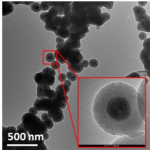The interdisciplinary research conducted at LEMAF includes the design, synthesis and functional characterization of pure or composite luminescent materials of inorganic and/or inorganic-organic nature for the development of prototypes aimed at photonic and bio-photonic applications. Among the materials of interest are:
i) Films and monoliths of silicate or organo-silicate matrices obtained by sol-gel methodology and loaded with luminescent complexes of lanthanide and other transition metals (e.g., Eu3+, Cu2+) with emphasis in the triplet emitters Ir(III) and Pt(III). Provided that the guest molecules concentrations are optimized to maximize dispersion or molecular aggregation, the materials can lead to high quantum yields at the visible spectral region and can be used in white light generation, organic solar cells enhancement, bio-imaging, photodynamic therapy of malign cells and microorganisms, etc;
ii) NaYF4 nanoparticles doped with Er3+/Yb3+ and Tm3+/Yb3+ operating via energy upconversion (UCNPs) associated to species susceptible to resonant energy transfer (LRET), aiming at paper sensors for pathogenic bacteria;
iii) Supramolecular nanostructures based on the UCNPs decorated with cyclodextrin and azobenzene (AZO), in the presence of Au metallic NPs, to assess the susceptibility of the luminescent response to the plasmonic effect. The effect is made possible (or hindered) by the cis-trans conformational photo-response of the AZO “switch” that leads to the assembly/disassembly of the system;
iv) CdTe and CdS quantum-dots for HHG (high harmonic generation) via plasmon induced by femtosecond lasers;
v) Silicates and sulphates doped with rare-earth ions that show persistent luminescence and scintillation. These materials are obtained by Microwave-Assisted Solid-State Synthesis (MASS) and can be studied in composite form when incorporated in phosphate and silicate glasses obtained by melt-quenching and/or sol-gel.
Besides the conventional characterization of these materials, structural studies by means of Raman and solid-state NMR and EPR techniques are used to feedback the synthesis and processing of the materials. The luminescent functional properties are evaluated via steady-state and time-resolved photoluminescence spectroscopy (absolute quantum yield, excited state lifetime). For the biological (or bio-related) tests we rely on our collaborations with other research groups located at the São Carlos Institute of Physics, at the São Carlos Institute of Chemistry, and at other institutions in Brazil and abroad. This line of research includes collaborating researchers in Germany, Spain, Chile and Uruguay.

NaYF4:(Yb,Er) UCNPs covered with mesoporous silica and luminescence by upconversion.

Hybrid sol-gel materials based on Ir(III) complexes

